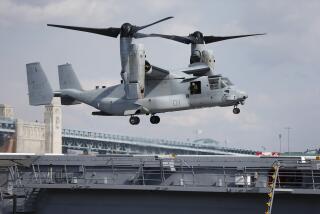Air Safety Isn’t Negotiable : Agencies Responsible for the Chaos Face Action in Congress
- Share via
When there is fear in the sky, Congress will react by passing laws on the ground.
This is what Congress is about to do in reaction to the increasing concern that there is no “safety net” under our nation’s air traffic control system. The recent clash of the National Transportation Safety Board and the Federal Aviation Administration over the NTSB’s proposal to restrict rush-hour flights has only increased the pressure on Congress to do something about our nation’s crowded skies.
Travelers have been deeply concerned about air traffic safety ever since President Reagan fired 11,000 air traffic controllers in 1981 during an illegal strike. Six years later the concerns and fears of airline passengers have not abated; indeed, they have gotten worse, and with good reason.
Airline passengers are increasingly frustrated by the “cattle car” approach that most carriers have adopted toward their customers. Passengers feel that they are at the mercy of “bait and switch” scheduling, outrageous overbookings and constant delays, and they sense that they must have all the skills of a Wall Street arbitrageur in order to buy a ticket.
Congress is equally concerned that six years after the air traffic controllers’ strike, the National Transportation Safety Board is in direct conflict with the Federal Aviation Administration over air safety.
The NTSB believes that there has been a significant “erosion of safety.” For his part, FAA Director Donald D. Engen responds to the complaints by calling for an “unemotional examination of the facts.” But an “unemotional examination of the facts” between two contending federal agencies is not what the average passenger wants when he or she boards a plane.
Most of us who fly still get butterflies when the captain announces that there “is turbulence ahead and would we kindly return to our seats.” Being told by the NTSB that it has gotten “butterflies,” too, is not reassuring. Americans who fly have a right to believe that their government is doing more than just having bureaucratic dogfights over disputed facts to assure their safety.
Rapid steps to reassure the American public about air safety must be taken. Five immediate steps seem in order:
--Engen should be given credit for increasing the accuracy of FAA reporting of “near misses,” which has exposed the severity of the problems encountered by pilots. The corollary to this commendation must be Engen’s recognition that there is a dangerous mismatch between his system’s current capability and the fierce competitive growth of air traffic since deregulation. The decision to hire 955 new controllers and support staff is long overdue and only came about because of sustained congressional pressure.
--The Administration must stop dealing with 1987 safety problems in a 1981 political context. The controllers’ strike is history. Having made its decision to hire new controllers, the FAA should also end its refusal to rehire the strikers. They have taken their punishment. The safety of airline passengers should not be compromised by the Administration’s obdurant refusal to change its political stance.
--The Administration must rapidly get its own house in order. Congress is not prepared to watch a bureaucratic tug of war between the FAA and the NTSB during the peak summer traveling months. It would be wise for the FAA to reconsider its outright rejection of the board’s proposal to cap air traffic in major corridors.
If the Administration will not act as referee and respond to public concern, then Congress will quickly move into the vacuum and mandate that the FAA accept the NTSB recommendations. If Administration officials want to describe congressional concerns as “gibberish and nonsense,” they will find out just how quickly they can be grounded by congressional hearings.
--The modernization of the nation’s air traffic system is critically behind schedule, with delays ranging from one to eight years at some facilities. The FAA has been unable to spend $1.6 billion in funds authorized for the completion of this modernization. Simply put, it has not been able to accomplish as much as originally anticipated in the 1981 National Airspace System plan.
--Finally, it may be time for the FAA to be transformed into an independent safety agency outside the purview of the Department of Transportation. I believe that the FAA’s reluctance to cap air traffic this summer is evidence of a dangerous conflict of interest between its two mandates--to promote commercial aviation and regulate air safety. Surely, safety should come first.
Turbulence, whether it is in the air or on the ground, makes the flying public nervous. In the air, those of us who fly must depend on the skill and dedication of airline pilots and air traffic controllers to get us safely from point to point. But on the ground, Congress reacts to bureaucratic turbulence by taking a closer look at the problem. This summer the FAA and the Administration should expect some turbulence from the Congress until the American people are reassured that their safety has been put first.
More to Read
Sign up for Essential California
The most important California stories and recommendations in your inbox every morning.
You may occasionally receive promotional content from the Los Angeles Times.










